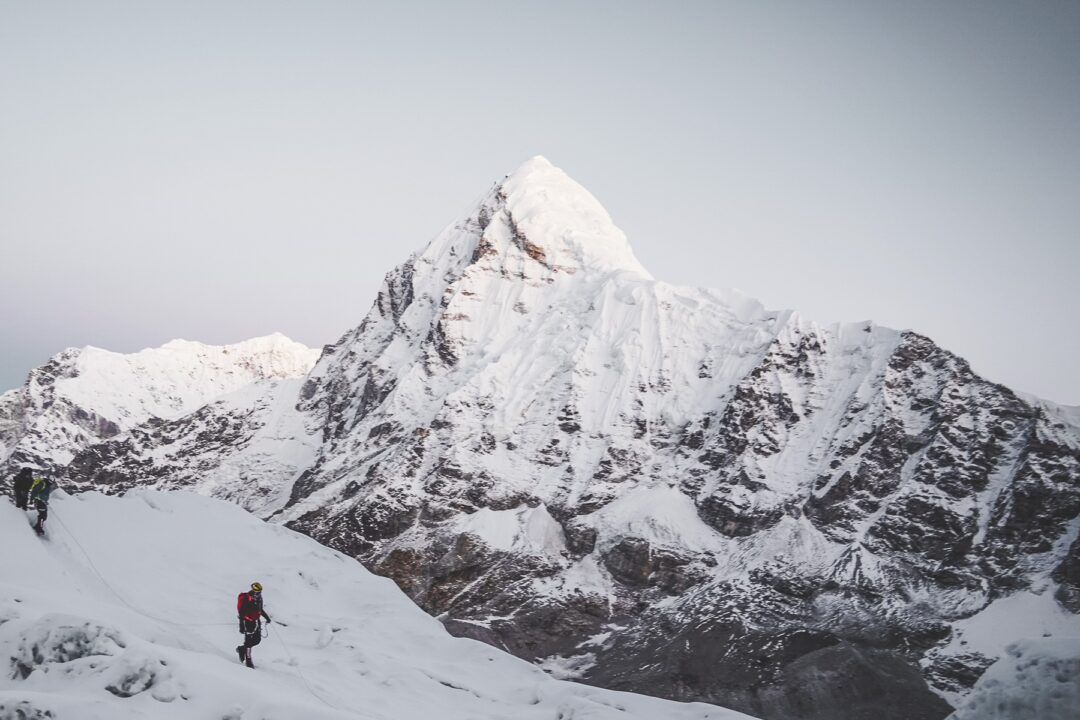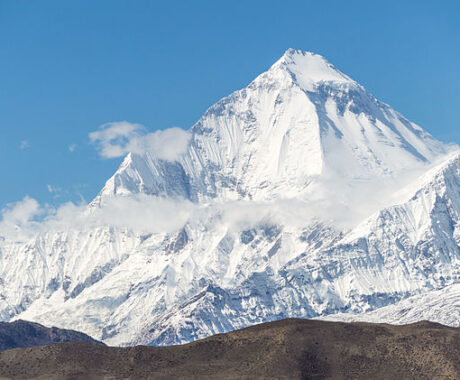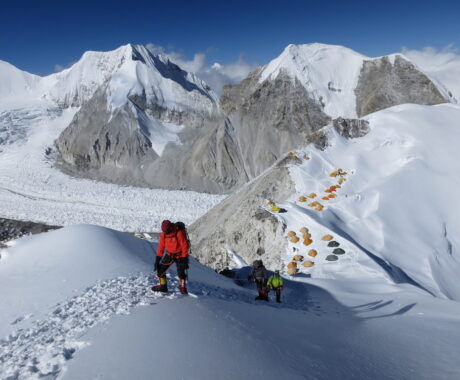Pumori Expedition

Trip Facts
- Destination Nepal
- Activity Expedition
- Duration 34 Days
- Trip Difficulty moderate
- Max. Altitude 7616 meters
- Best Time Autumn and Spring
- Start and End Kathmandu - kathmandu
- Meals Breakfast, Lunch, and Dinner
- Accommodation 5 star Hotel in Kathmandu / Tea house / Camping
- Group Size 2 - 12
- Transportation Private transport & Flight Ticket
Trip Highlights
- Magnificent vistas of Khumbu Valley and mountains, as well as of Everest, Lhotse, Cho Oyu, Makalu, and Nuptse
- Discover the genuine customs and culture of the Sherpas
- Traversing the difficult glacier that is the Khumbu Icefall
- Chance to see monasteries and get a taste of Himalayan culture
- The technical difficulty with exposed peaks, steep slopes, and portions with a combination of rock and ice
Introduction
With a peak as high as 7000 meters, the Pumori Expedition is a tough mountain climb. One of Nepal’s most difficult 7000-meter expeditions is to climb Mount Pumari (7161 meters/27,494 feet). Located in Mahalangur Parbat in the Himalayas, Pumori has a border with both China and Nepal.
Mount Pumori, located south of Kala Patthar, resembles a snow-capped pyramid. Climbing Mount Pumori is mostly worth it for the breathtaking views of Tibet, Mount Everest, and the Rongbuk Glacier.
In Sherpa language, “Ri” means mountain, and “Pumo” means young girl or lady. Mt. Pumori is one of the gleaming, pointed peaks of Nepal’s 7,000-meter Himalayas. “Pumori” translates to “Unmarried Daughter” in the Sherpa language. A trip to the top of Pumori gives an incredible perspective of the surrounding peaks in the Everest area, making it an adventure of a lifetime.
Mount Pumori, which rises to 7616 meters, may be reached by two paths. Both routes use the same path up to Pumori Base Camp, which is reached after an exhilarating flight from Kathmandu to Lukla. The Southeast Ridge is the path for climbing; it’s a technically difficult mountain with parts of wild exposure that require a high degree of physical fitness and prior mountaineering expertise.
In 1962, German-Swiss expedition leader Gerhard Lenser made the first ascent of Pumori. Since 1962, there have been about 600 individuals at Pumori’s peak. Pumari boasts one of the most breathtaking vistas of Tibet, which includes the Rongbuk glacier, and Mount Everest. Although the Southeast is the typical climbing route, the summit has also been climbed from the Southwest and Southeast.
Climbing Mt. Pumori is suitable in both the spring (March to May) and autumn (September to November). There is less chance of an avalanche and the technical difficulties are not very great. The southern ridge is the other common path that you might use. It is the second most popular route to climb, and while avalanche danger is minimal, many aspects of rock climbing call for strength and technique.
Best seasons for the Pumori Expedition
The weather in the Himalayas may be severe and erratic at times. It is important to determine the appropriate time and season to explore the harsh and untamed environment of high altitude.
Spring (March to May)
Climbing Pumori and other high-altitude Himalayan peaks is particularly popular during this time of year. While it’s still chilly, the temperatures are more tolerable and the winds aren’t as strong as they would be during other times of the year.
Compared to other seasons, the wind will be milder and the track simpler to follow. Because spring offers a fantastic perspective of the area, quicker access, and a high success rate, mountaineers choose this time of year.
Summer/Monsoon (June to August)
The area receives a lot of rainfall, and there may be a substantial quantity of snowfall in the mountain’s top regions. Because of snowfall and the risk of an avalanche, climbing Pumori is not recommended during the monsoon season (mid-May to September). Around September, there will be a lot of snowfall, therefore avalanches may happen often throughout the day.
Fall / Autumn (September to November)
The second most popular time of year to climb Pumori is around fall. Great views of the neighboring peaks are often possible when the skies clear after the monsoon. While it is usually dry and steady, the temperature might drop, particularly at night, compared to the spring.
The snowpack is stable, the wind is quiet, and the daytime high is mild, signifying the season.
Winter (December to February)
Another difficult season for a Pumori trek is the winter. Extreme and dangerous climbing conditions result from repeated strong storms and sharp drops in temperature. Even the easiest parts of the climb may become hazardous due to the cold and strong gusts.
Pumori experiences -35°C and below temperatures throughout the winter months of late December to early February (depending on wind currents).
Pumori expedition Difficulty
Any summit’s difficulty level is dependent on a variety of elements, including the temperature and weather, the route you take, the climber’s physical fitness, your mountaineering skills, your ability to climb high altitudes, the distance you must cover, your clothes and equipment, and more.
The climb requires experience in narrow ridge traversing, ice climbing, and rock climbing due to its steep and exposed aspects. Using technical equipment like crampons, ice axes, and ropes is crucial.
There is less chance of an avalanche and the technical difficulties are not very great. The southern ridge is the other common path that you might use. It is the second most popular route to climb, and while avalanche danger is minimal, many aspects of rock climbing call for strength and technique.
Acute Mountain Sickness (AMS) is also a risk at high altitudes due to low oxygen levels and low air pressure. Therefore, it is essential to regularly acclimatize, stay hydrated, and adopt a relaxed mindset to avoid it.
The Pumori Expedition’s difficulty is mostly determined by the weather. Pumori is situated in an area with severe and erratic weather patterns. Strong winds, a lot of snowfall, bitterly low temperatures, and abrupt weather changes are all things that climbers need to be ready for.
Itinerary Outline
Day 01: Arrival in Kathmandu & Transfer to the Hotel – 1,300m
Day 02: Kathmandu Expedition Preparation day in Kathmandu group meeting
Day 03: Fly to Lukla & Trek to Phakding 2,610m
Day 04: Trek from Phakding to Namche Bazaar – 3,440m
Day 05: Acclimatization at Namche Bazaar (Rest Day).
Day 06: Trek to Tengboche – 3,900m
Day 07: Trek to Dingboche – 4,400m
Day 08: Trek from Dingboche to Lobuche – 4,930m
Day 09: Trek from Lobuche to Gorekshep – 5,180m
Day 10: Trek from Gorekshep to Pumori Basecamp – 5,220m
Day 11-28: Climbing Period [Base Camp – Pumori Summit (7,145m) – Base Camp
Day 29: Trek from Base Camp to Pangboche – 3,930m
Day 30: Trek to Namche Bazaar – 3450m
Day 31: Trek back to Lukla – 2810m
Day 32: Fly from Lukla to Kathmandu – 1,300m
Day 33: Free Day in Kathmandu – 1,300m
Day 33: Final Departure from Kathmandu – 1,300m
Alternative Expeditions Around Pumori Expedition
The Pumori Expedition is a thrilling challenge for mountaineers aiming to summit Pumori (7,161m), a stunning peak located just 8 km west of Mount Everest. Known as the “Daughter of Everest,” Pumori is a technical climb that demands experience in high-altitude mountaineering and offers breathtaking views of Everest, Lhotse, and the Khumbu region.
If you’re seeking alternative expeditions with similar technical difficulty, altitude, or region, here are some great options:
- Ama Dablam Expedition – 35 Days: Known for its striking beauty, this technical climb offers an exciting challenge with panoramic views of the Everest region, perfect for mountaineers seeking a demanding yet rewarding summit.
- Mt. Everest Expedition – 60 Days: For the ultimate mountaineering experience, this expedition offers the chance to summit the world’s highest peak. It’s an extreme challenge that requires advanced climbing skills and endurance.
- Mt Makalu Expedition – 56 Days: For experienced mountaineers, this expedition to the fifth-highest peak in the world combines technical difficulty and incredible views, offering a more remote alternative to Everest.
Detailed Itinerary
-
Day 01: Arrival in Kathmandu & Transfer to the Hotel - 1,300m
Altitude: 1300mMeals: BreakfastAccommodation: 3 star hotel in Kathmandu -
Day 02: Kathmandu Expedition Preparation day in Kathmandu group meeting
Altitude: 1300mMeals: BreakfastAccommodation: 3 star hotel in Kathmandu -
Day 03: Fly to Lukla & Trek to Phakding - 2,610m
Altitude: 2610mMeals: Breakfast / lunch / DinnerAccommodation: Tea house -
Day 04: Trek from Phakding to Namche Bazaar - 3,450m
Altitude: 3450mMeals: Breakfast / lunch / DinnerAccommodation: Tea house -
Day 05: Acclimatization at Namche Bazaar Rest Day - 3450m
Altitude: 3450mMeals: Breakfast / lunch / DinnerAccommodation: Tea house -
Day 06: Trek to Tengboche - 3,900m
Altitude: 3900mMeals: Breakfast / lunch / DinnerAccommodation: Tea house -
Day 07: Trek to Dingboche - 4,400m
Altitude: 4400mMeals: Breakfast / lunch / DinnerAccommodation: Tea house -
Day 08: Trek from Dingboche to Lobuche - 4,930m
Altitude: 4940mMeals: Breakfast / lunch / DinnerAccommodation: Tea house -
Day 09: Trek from Lobuche to Gorekshep - 5,180m
Altitude: 5180mMeals: Breakfast / lunch / DinnerAccommodation: Tea house -
Day 10: Trek from Gorekshep to Pumori Basecamp - 5,220m
Altitude: 5220mMeals: Breakfast / lunch / DinnerAccommodation: Camping -
Day 11-28: Climbing Period [Base Camp – Pumori Summit (7,145m) – Base Camp
Altitude: 5200m - 7145mMeals: Breakfast / lunch / DinnerAccommodation: Camping -
Day 29: Trek from Base Camp to Pangboche - 4,000m
Altitude: 4000mMeals: Breakfast / lunch / DinnerAccommodation: Tea house -
Day 30: Trek to Namche Bazaar - 3450m
Altitude: 3450mMeals: Breakfast / lunch / DinnerAccommodation: Tea house -
Day 31: Trek back to Lukla - 2810m
Altitude: 2810mMeals: Breakfast / lunch / DinnerAccommodation: Tea house -
Day 32: Fly from Lukla to Kathmandu - 1,300m
Altitude: 1300mMeals: BreakfastAccommodation: 3 star hotel in Kathmandu -
Day 33: Free Day in Kathmandu - 1,300m
Altitude: 1300mMeals: BreakfastAccommodation: 3 star hotel in Kathmandu -
Day 34: Final Departure from Kathmandu - 1,300m
Altitude: 1300mMeals: Breakfast
What's included
What's not included
FAQs of Pumori Expedition
-
Is Pumori a technically difficult peak?
Indeed, Pumori is regarded as a technically difficult summit that calls for familiarity in roped glacier transit, ice climbing, and mountaineering. -
Does attempting Pumori need any prior climbing experience?
Yes, it is strongly advised to have prior climbing expertise. It is recommended that climbers have prior high-altitude climbing experience, technical mountaineering expertise, and equipment familiarity. -
Do I need an oxygen cylinder and other medical supplies?
The 7,161-meter Mount Pumori doesn't require an oxygen tank or any other medical supplies. However, occasionally because of the great altitude, you could require the appropriate equipment in case of an emergency. -
How do I avoid altitude sickness?
Gradually rise or fall to a high altitude to give your body time to acclimatize to lower oxygen levels. Avoid alcohol, drink as much water as you can, and always eat to the maximum when you eat. Don't take a high-altitude flight directly to a region. -
When is the best time to go on the Pumori expedition?
Similar to many trekking trails in Nepal, spring and autumn are the finest times of year to explore Pumori. The course will be easier to follow and the wind will be softer than in previous seasons. -
Does the Pumori Expedition require permits?
Indeed, to ascend Pumori, climbers must get climbing permission from the Nepal Mountaineering Association (NMA). A permission to enter Sagarmatha National Park is also necessary. -
What lodging choices are available for the Pumori Expedition?
Tents are available for lodging at the base camp and upper sites during the excursion. Higher camps tend to have more rustic tent arrangements, whereas Base Camp often has more modern amenities, such as dining tents.
Trip You May Like

Mt. Dhaulagiri Expedition

Cho Oyo Expedition

Mt Makalu Expedition





